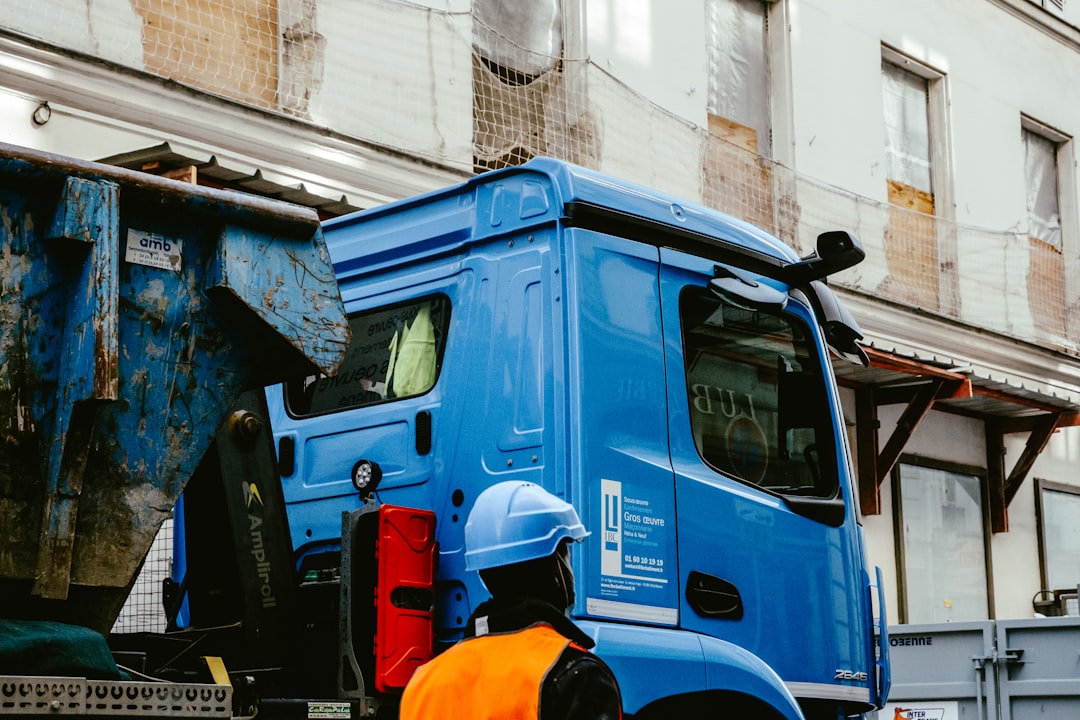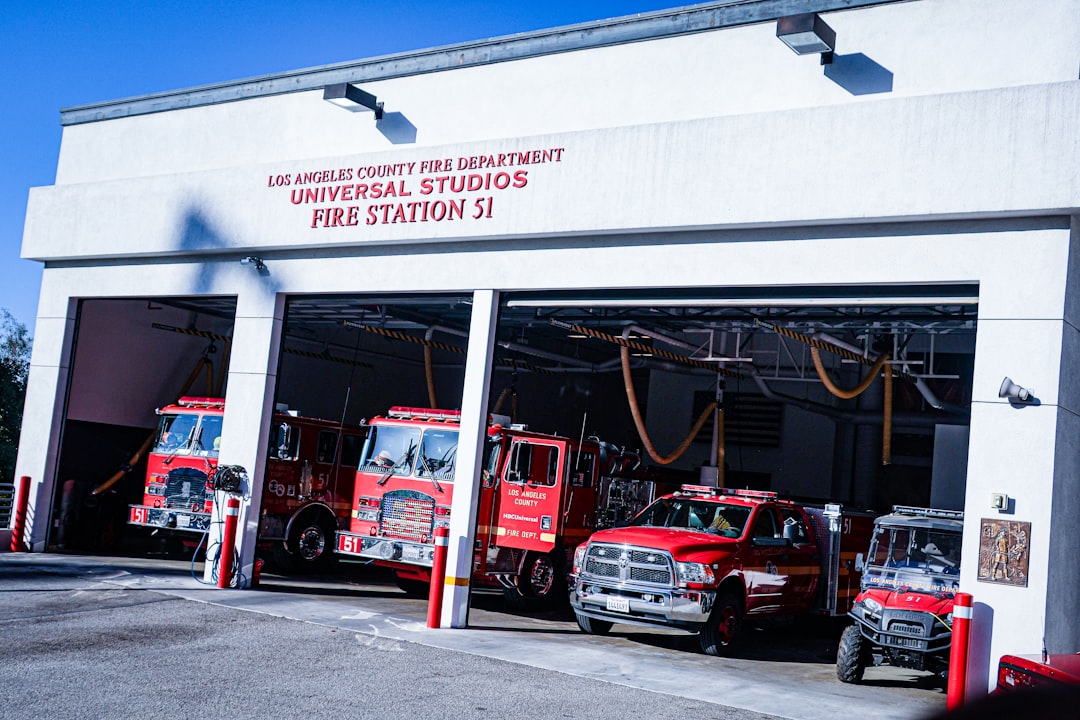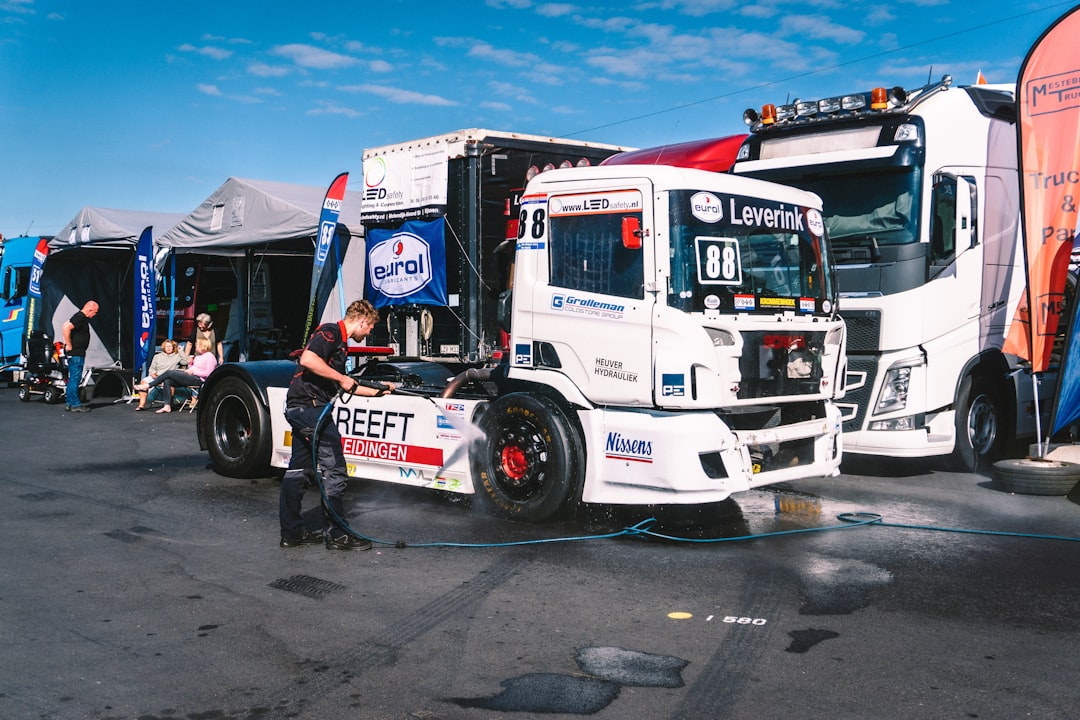

Engage prospects with a scan and streamline customer engagement with FREE QR code marketing tools by Sona – no strings attached!
Create a Free QR CodeFree consultation

No commitment

Engage prospects with a scan and streamline customer engagement with FREE QR code marketing tools by Sona – no strings attached!
Create a Free QR CodeFree consultation

No commitment
QR codes have evolved from simple conveniences to powerful tools that bridge the gap between offline interactions and online engagement. For truck repair services, where service speed, information access, and operational accuracy are crucial, QR codes create seamless connections between physical assets such as shop signage, vehicle dashboards, invoices, and parts with digital experiences that keep essential resources at every customer’s fingertips.
Operational efficiency, customer trust, and direct access to information are vital in the highly specialized truck repair sector. However, many shops still rely on static materials, manual entry, and phone-based workflows, which often lead to missed opportunities to capture and convert high-value prospects. QR codes help by supplying instant access to service menus, repair histories, maintenance tips, and real-time booking within seconds of a scan, while automatically capturing valuable service and customer data.
By transitioning from paper-based processes to dynamic, QR-powered touchpoints, truck repair professionals can overcome the challenges of missing high-value prospects and incomplete lead tracking. This approach increases lead capture rates, boosts customer satisfaction, and enables data-driven growth, streamlining outdated processes that hamper timely engagement.

Truck repair shops often struggle with bottlenecks created by paper forms, printed brochures, and lengthy manual inquiry calls, especially during peak breakdown periods. This dependence on analog systems can cause costly delays, lost leads, or incomplete customer records. QR codes replace these slow touchpoints with direct digital routes that capture intent and streamline the next step, from check-in to payment.
QR codes create a direct pipeline between every physical interaction and vital digital resources. When integrated with a platform like Sona QR’s product overview, each scan can be tracked, segmented, and connected to follow-up workflows. That means service advisors gain visibility into who scanned, when they scanned, and what they want to do next, all without forcing customers to download an app or wait on hold.
Modern QR platforms also allow for person and vehicle level identification using forms, unique parameters, and CRM enrichment. With purpose-built QR workflows, truck repair professionals can enrich customer profiles for targeting, trigger timely follow-ups, and ultimately convert more interested visitors into long-term customers. Common analog processes that benefit from QR upgrades include printed brochures replaced by mobile service menus, paper check-ins replaced by digitized intake, and manual phone estimates replaced by QR linked cost calculators and photo upload forms.

Truck repair providers face unique challenges: unplanned breakdowns, a transient customer base, urgent service needs, and a high volume of anonymous traffic. Leads often slip away because there is no easy way to connect offline intent with online follow-up. A driver might see a shop flyer at a fuel stop or a poster at a weigh station, but without a fast way to engage, interest fades quickly. Lack of visibility means valuable prospects might never receive targeted support or may look elsewhere if outreach is delayed.
QR codes close this gap by turning every offline impression into a measurable digital action. A scan can open a booking form, send a preformatted text for roadside assistance, or pull up a maintenance checklist. When connected to Sona QR, the shop can see which placements get scanned most, segment audiences by behavior, and route high intent requests to advisors immediately. This combination of speed and data is especially powerful in time sensitive repair scenarios where minutes matter.
QR powered touchpoints reduce friction, capture every opportunity, and create the attribution trail you need to invest confidently in the tactics that work.

Repair providers often find traditional marketing channels fail to personalize outreach or capture granular engagement data. QR codes solve this by supporting multiple formats that directly map to common service workflows. The most useful types in truck repair are those that connect people to booking, communication, documentation, and network access in one or two taps.
Choose the format that matches the job to be done, then set a destination that advances the user to the next meaningful action. Dynamic codes are recommended for most placements so you can track performance, update links, and A/B test landing pages over time. Static codes work for fixed content like a PDF of non changing shop policies or a permanent Wi-Fi network.
A centralized platform like Sona QR allows teams to generate, manage, and track all formats in one place, so marketing, operations, and service share a single source of truth on performance.

Many shops overlook high impact offline touchpoints where prospects interact but are not tracked. Identifying these high traffic, high value locations for QR code deployment transforms analog surfaces into measurable conversion points. Start by mapping your typical customer journey and noting every physical moment where attention is high and action should be easy.
Think beyond the shop and include spots where drivers spend time on the road. Fuel stations, rest areas, fleet yards, and weigh stations can double as brand building and lead capture opportunities when you add compelling scan to action prompts. Combined with unique QR codes per placement, you will quickly see which locations convert and which need new messaging. For ideas on placements, see QR on trucks.
A holistic approach ensures each prospect is identified early and routed to the right next step, minimizing the risk of lost opportunities and expanding your addressable audience with every route your drivers run.

Truck repair journeys are often fragmented, with missed engagement opportunities due to delayed lead capture or lack of personalization. QR codes tie these moments together by making it easy to act and easier for shops to respond. To get started, align each use case with a desired outcome and a clear placement strategy so the right people see the right prompt at the right time.
The following use cases reflect common interactions in heavy duty and diesel repair shops, mobile roadside operations, and fleet service centers. Each is designed to reduce friction for drivers and dispatchers while feeding accurate, actionable data into your CRM.
These use cases turn traditionally untraceable, analog touchpoints into rich sources of actionable CRM data. When paired with dynamic codes and Sona QR’s tracking, you can measure which use cases deliver the most revenue and redirect resources accordingly.
A common challenge in truck repair is the inability to segment or retarget prospects who show interest but never complete a form or call. QR codes help solve this by capturing intent signals in context. Every scan creates a timestamped event tied to a location and a use case, which can be synced to your CRM and ad platforms for precise follow up. For strategy, see Sona’s blog post titled The Essential Guide to Intent Data: Leveraging Signals to Increase Revenue.
By deploying multiple QR codes across different touchpoints, you can auto segment audiences such as owner operators vs fleet managers, scheduled maintenance seekers vs emergency breakdowns, or local drivers vs highway pass through traffic. Each segment can then receive tailored messaging, offers, and outreach cadence that matches their urgency and buying stage.
With Sona QR, each scan becomes a smart entry point into your funnel. You can build audiences based on real behavior, not assumptions, which drives higher response rates and better return on ad spend.
Disconnected marketing channels create disjointed experiences and revenue leakage. QR codes act as connectors across print, physical signage, mobile units, and digital campaigns, giving drivers and fleet managers a fast onramp to the action you want them to take. They also give marketers and operators the data needed to see which channel is working and why.
In truck repair, the most common media include invoices, brochures, yard signage, shop windows, billboards near exits, and decals on service vehicles. Layering QR codes into these placements turns static assets into live performance media, complete with conversion paths and attribution data. The result is an offline to online funnel that is faster, more measurable, and easier to optimize.
A centralized platform like Sona QR ties all touchpoints together for full funnel visibility, precise targeting, and rapid optimization. You will know which placements create pipeline, how quickly leads progress, and where to double down.
A well executed QR campaign begins with clarity on the job to be done, followed by rigorous design, testing, and tracking. The checklist below adapts general best practices to the realities of diesel and heavy duty repair, where urgency, accuracy, and mobile friendliness determine outcomes. Use it to set up your first campaign or to standardize how your team scales QR across locations and vehicles.
Each step includes specific tips for truck repair teams, along with suggestions for tools and tests that reduce friction for drivers and dispatchers. When possible, use dynamic QR codes so you can update destinations and capture detailed analytics without reprinting.
Define your campaign goal in concrete terms. Examples include “increase weekend mobile repair requests by 25 percent,” “capture 80 percent of lobby visitors with digital check in,” or “generate 50 new maintenance plan sign ups from fuel stop posters this quarter.” Align the QR code’s purpose with a measurable business outcome and a clear next action.
Choose between static and dynamic codes. Static works for permanent content like shop rules or a general vCard. Dynamic is best for campaign destinations, A/B tests, retargeting, and any link you might update. Dynamic also unlocks more detailed analytics and integration options.
Design for visibility, trust, and clarity. Add your logo, use brand colors, and frame the code with a highly specific call to action. Make the CTA benefit oriented and action oriented, such as “Scan for immediate roadside help” or “Scan to get today’s open slots.” Then test thoroughly. Browse custom QR designs tailored for truck branding.
Roll out codes where your audience already is. Prioritize entrance signage, estimate sheets, waiting area posters, service bay placards, dashboard stickers, vehicle wraps, and direct mail. Pair each placement with a unique code so you can compare performance and refine your inventory.
Use a centralized QR platform to monitor scans, actions, timing, and source channel. Set benchmarks such as scans per 100 impressions, scan to form completion, and scan to booking conversion. Review weekly, optimize monthly, and roll out winners quarterly.
Truck repair operators struggle to connect inbound interest to revenue when tracking is manual or fragmented. Without a clear view of the path from scan to booking and invoice, teams over invest in placements that generate curiosity rather than conversions and under invest in the assets that quietly produce profitable jobs. QR code analytics solve this by turning every scan into a measurable, attributable event.
With Sona QR, you can capture comprehensive scan history, track performance by placement, and attribute bookings to the specific assets that drove them. Sona.com extends this by linking scans to web sessions, email engagement, ad clicks, and CRM activity, creating a complete buyer journey from first touch to closed invoice. For a framework, read Sona’s blog post titled The Essential Guide to Offline Attribution: Maximizing ROI Through Offline Channels. The result is faster optimization and greater confidence in your marketing spend.
QR analytics allow truck repair businesses to build smarter pipelines and align outreach with actual prospect behavior. Over time, you will know which messages move the needle for each audience and environment, which reduces waste and increases bookings.
Sustained success with QR codes depends on consistent execution, clear calls to action, and disciplined tracking. Once your initial campaigns are running, expand into new placements and refine your segments so every scan triggers the right response. The most successful shops treat QR like a core channel that spans operations and marketing rather than a one off experiment.
Training the front line matters as much as the technology. Service advisors and technicians should know how to explain the value behind each code. A quick, confident script can double scan rates and improve satisfaction since customers feel guided rather than left to figure it out on their own.
You can generate and track your first QR codes for free with Sona QR. Start creating QR codes for free, create dynamic codes with branded frames, and connect them to your CRM to begin capturing measurable results within days.
High value prospects are often missed when they are not tracked, outreach is delayed, or engagement signals go unseen. QR codes provide a powerful solution for truck repair services by bridging the offline to online gap, making every interaction digitally actionable, and fueling robust analytics, retargeting, and growth. They transform the most common surfaces in your business into gateways that capture demand at the source and guide customers to the right next step.
With modern QR platforms like Sona QR, repair providers gain instant access to digital resources, smoother customer journeys, and the ability to act on every lead before competitors. Sona.com adds identity resolution and multi touch attribution so you can connect scans to revenue and scale what works with confidence. See Sona’s blog post titled The Importance of Accurate Revenue Attribution to strengthen your measurement approach. As more shops embrace data driven execution, QR codes become essential for sustained success in a competitive, time sensitive marketplace.
QR codes are redefining best practice in truck repair services by making every physical touchpoint both trackable and actionable. By capturing valuable engagement data at the earliest possible moment, empowering quick response, and surfacing upsell or retention opportunities that once went unnoticed, modern QR solutions equip repair providers to grow high quality leads, streamline workflows, and boost customer satisfaction. Integrating QR technology is no longer optional; it is now central to scaling your business with speed, clarity, and measurable impact.
QR codes have revolutionized the truck repair services industry by transforming traditional service access into seamless, instant interactions. From streamlining vehicle diagnostics to providing real-time repair status updates, QR codes enhance customer experiences and drive operational efficiency. Imagine your customers effortlessly accessing service histories or scheduling appointments with a simple scan—boosting satisfaction and loyalty while reducing administrative delays.
With Sona QR, creating dynamic, trackable QR codes tailored for truck repair services is effortless. Instantly update repair instructions, track scan engagement, and connect every interaction to increased customer retention and revenue—without the need for costly reprints. No more guesswork, just clear insights and powerful tools to grow your business.
Start for free with Sona QR today and turn every scan into a faster repair, a happier customer, and a stronger bottom line.
QR codes improve operational efficiency, enhance customer trust, enable instant access to service information, capture valuable lead data, and streamline workflows from check-in to payment.
QR codes replace slow analog touchpoints with direct digital routes for check-in, diagnostics, scheduling, feedback, and service history access, reducing delays and data entry errors.
Common QR code formats include web links for booking and FAQs, forms for diagnostics and intake, vCards for contact info, SMS or email triggers for urgent requests, and Wi-Fi access codes for network connectivity.
Effective placements include shop entrances and lobbies, invoices and parts packaging, mobile units and roadside fleets, out of home advertising like billboards and posters, and vehicle decals.
By deploying multiple QR codes with unique tracking, shops can segment prospects by behavior, urgency, and location, enabling tailored messaging, retargeting, and personalized outreach.
Define clear goals and audiences, choose dynamic QR codes, design with visible and trust-building elements, deploy across high-impact channels with unique codes, then track and optimize performance regularly.
QR analytics provide data on scan locations, timing, and conversion rates, allowing shops to identify high-performing assets, prioritize channels, and adjust offers for better bookings and revenue.
Use cases include maintenance history lookup, appointment booking and cost estimation, and emergency mobile repair requests, all enabling faster service and accurate data capture.
Using QR codes to access maintenance tips, service histories, and preventive reminders helps drivers and fleet managers keep up with recommended upkeep and reduce breakdowns.
Dynamic QR code platforms like Sona QR integrate with CRM systems to track scans, automate workflows, enable real-time booking, and provide detailed analytics for smarter marketing and service.
Use Sona QR's trackable codes to improve customer acquisition and engagement today.
Create Your FREE Trackable QR Code in SecondsJoin results-focused teams combining Sona Platform automation with advanced Google Ads strategies to scale lead generation

Connect your existing CRM

Free Account Enrichment

No setup fees
No commitment required

Free consultation

Get a custom Google Ads roadmap for your business






Launch campaigns that generate qualified leads in 30 days or less.
